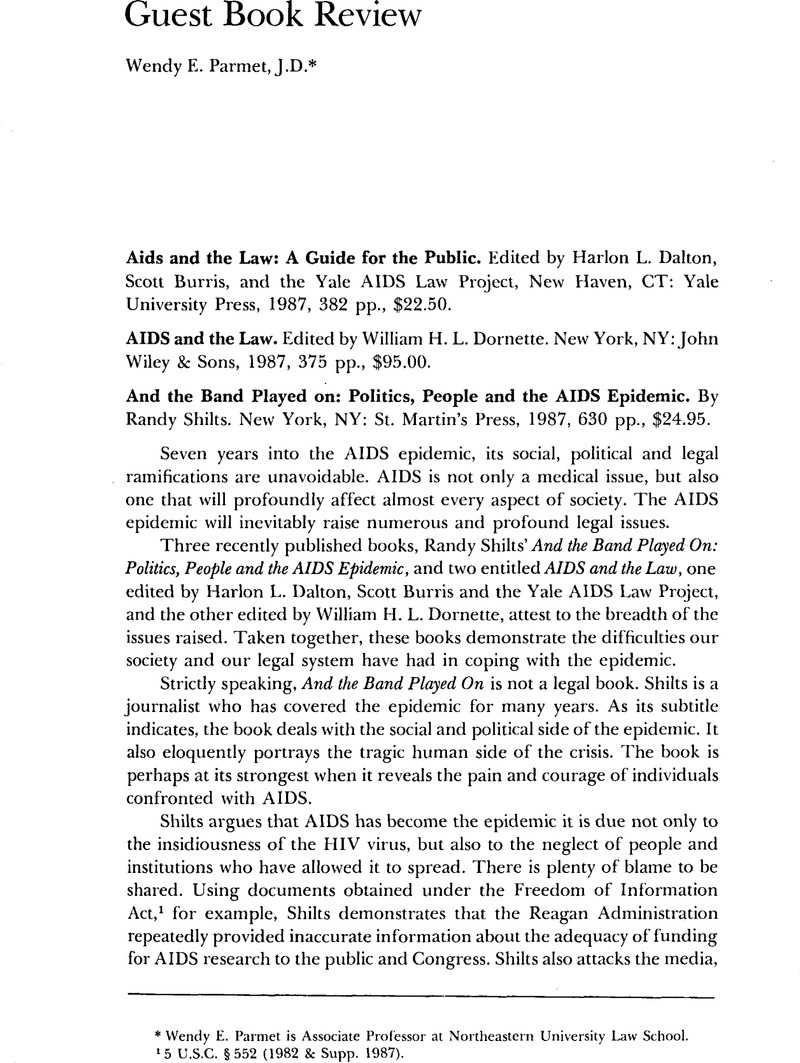No CrossRef data available.
Article contents
Aids and the Law: A Guide for the Public. Edited by Harlon L. Dalton, Scott Burris, and the Yale AIDS Law Project, New Haven, CT: Yale University Press, 1987, 382 pp., $22.50. - AIDS and the Law. Edited by William H. L. Dornette. New York, NY: John Wiley & Sons, 1987, 375 pp., $95.00. - And the Band Played on: Politics, People and the AIDS Epidemic. By Randy Shilts. New York, NY: St. Martin's Press, 1987, 630 pp., $24.95.
Published online by Cambridge University Press: 24 February 2021
Abstract

- Type
- Medicolegal Reference Library
- Information
- American Journal of Law & Medicine , Volume 12 , Issue 3-4: Public Health & The Law , 1986 , pp. 503 - 509
- Copyright
- Copyright © American Society of Law, Medicine and Ethics and Boston University 1986
References
1 5 U.S.C. §552 (1982 & Supp. 1987).
2 U.S. Department of Justice, Office of Legal Counsel, Memorandum for Ronald E. Robertson, Re: Application of Section 504 of the Rehabilitation Act to Persons with AIDS, AIDS-Related Complex, or Infection with the AIDS Virus (June 23, 1986), reprinted in AIDS AND THE LAW (W. Dornette ed. 1987) App. I, at 286.
3 29 U.S.C. §794 (1982 & Supp. 1987).
4 Henry, AIDS in the Workplace, in W. Dornette, supra note 2, at 41.
5 107 S. Ct. 1123 (1987).
6 107 S. Ct. at 1128-30. Gregory's piece on education does contain a brief, but incomprehensible discussion of the Arline decision. Most likely, the decision came down while the book was in the publication process, leaving the author little or no time to incorporate a full discussion. No excuse exists, however, for the inconsistency in the analysis that is offered. It would have been far better had the editor simply noted that Arline was decided while the book was in press.
7 Henry's essay on workplace discrimination takes a much narrower view of employer discretion, and cautions employers that the prudent course is to follow workplace recommendations established by the Centers for Disease Control. See Henry, supra note 4, at 45. Similarly, Gregory criticizes the Cooper view as “unnecessarily technical.” Gregory, Educating the Infected Child, in W. Dornette, supra note 2, at 53.
8 For an insightful analysis concluding that criminal law is not a desirable means for fighting the infection, see generally Field, & Sullivan, , AIDS and the Criminal Law, 15 LAW MED. & HEALTH CARE 46 (1987).CrossRefGoogle Scholar
9 Robinson, Criminal Sanctions and Quarantine, in W. Dornette, supra note 2, at 174.
10 For example, Raymond C. O'Brien predicts that states will soon “seek to better safeguard the population with blood test requirements.” O'Brien, AIDS and the Family, in W. Dornette, supra note 2, at 110.
11 For a fuller discussion on the problems with quarantine, see Gostin, & Ziegler, , A Review of AIDS-Related Legislative and Regulatory Policy in the United States, 15 LAW MED. & HEALTH CARE 5, 11-12 (1987)CrossRefGoogle Scholar; Parmet, , AIDS and Quarantine: The Revival of an Archaic Doctrine, 14 HOFSTRA L. REV. 53, 83-87 (1985).Google Scholar
12 Much of the legal literature on AIDS adopts this perspective. See generally Leonard, , AIDS and Employment Law Revisited, 14 HOFSTRA L. REV. 11 (1985)Google Scholar; Parmet, supra note 11, at 84-87; Note, The Constitutional Rights of AIDS Carriers, 99 HARV. L. REV. 1274 (1986)CrossRefGoogle Scholar. Deborah Merritt argues that courts should apply a Rawlsian approach to reviewing the constitutionality of public health measures. Using this approach, she concludes that most public health restrictions against individuals infected with HIV would violate the equal protection clause, although some limited ones might pass muster. See Merritt, , Communicable Disease and Constitutional Law: Controlling AIDS, 61 N.Y.U. L. REV. 739, 792-99 (1986)Google Scholar. Many recent court decisions concerning AIDS adopt a rights-oriented approach. See, e.g., Chalk v. United States Dist. Court, 832 F.2d 1158 (9th Cir. 1987) (school teacher with AIDS is likely to prevail on claim that barring him from teaching violates § 504 of the Rehabilitation Act of 1973); Dist. 27 Comm. School Bd. v. Board of Educ, 130 Misc. 2d 398, 502 N.Y.S.2d 325 (Sup. Ct. 1986) (denying school board's request to deny admission to student with AIDS); Cronan v. New England Tel. Co., Mass. Sup. Ct. No. 80332 (Aug. 15, 1986) (discrimination against individual with AIDS violates state law). The Supreme Court opinion in Arline, 107 S. Ct. at 1123, may also be seen as adopting this approach.
13 The actual standard varies depending upon the particular right at issue. See supra note 12.
14 29 U.S.C. §§ 141-187 (1982).
15 29 U.S.C. §§ 651-678 (1982).
16 For a thoughtful overview of potential legal approaches to stemming the epidemic, see Gostin, , Viewpoint: The Nucleus of a Public Health Strategy to Combat AIDS, 14 LAW MED. & HEALTH CARE 226 (1985).CrossRefGoogle Scholar




